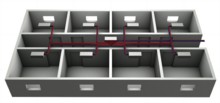Measure to know

Centralising the valves serving a number of terminal devices (eight in this case) makes it much easier to commission and balance them.
With the driving need for building-services and facilities managers to ensure internal environments are maintained in a sustainable way comes several considerations for dealing with waterborne heating and cooling systems. Pressure losses across balancing valves can ruin the control of a variable-flow water system, resulting in loss of internal climate control and accompanying complications such as irritating excess pipe noise. Peter Rees advocates the tried and tested method of differential pressure control and offers some advice on measuring the pressure across the system.To get the best out of a variable-flow water-distribution system, the controllers must be able to do just that — control the system. However, this can only happen if design flows prevail in the plant when necessary. The challenge faced by the system designer and building manager is that if the differential pressure varies too much it is necessary to stabilise it to prevent incorrect flow. Therefore, being able to keep differential pressure constant will improve control — ensuring a comfortable indoor climate with less noise, lower start-up as well as ongoing maintenance costs and overall energy efficient operation.
Impossible If pressure is lost across the balancing valves it becomes impossible to select 2-port control valves with any authority, so the engineer is unable to modulate the flow of water within the system. This in turn means that it is impossible to regulate the output at terminal units, making the resulting energy wasted far greater in terms of expense than that saved by regulating the pump speed as an alternative. This problem is exacerbated by the popularity of locating large differential-pressure control valves on floor branches, feeding from a vertical riser. This positioning divides a large system into manageable sections. However if these sections are also large, the modulating control valves are less likely to be able to regulate the pressure flow. For example, if the system is running at 50% of its design load, the flow will be at 20% — leading to a dramatic increase in differential pressure across the control valve in question. This in turn can lead to significant internal climate swings, as the controller will only be able to operate in on/off mode, leaving the building services engineer or facilities manager to either accept the unstable flow, widen the p-band and risk loosing accurate control of the system or balance the system with differential pressure controllers.
Stabilise Differential-pressure controllers stabilise the differential pressure and ensure stable and accurate modulating control — ensuring that the indoor climate is maintained. The added advantage is that a differential pressure controller allows the engineer to balance one circuit of a system, without influencing the others — a major benefit for larger projects. Selecting a differential pressure control valve, such as the STAP, that is sized according to the system will help to combat this problem by ensuring that any pressure loss across the valve is the same around the rest of the circuit. However, by partnering with a valve supplier that can pass on valuable technical expertise it may be possible to install a valve that combines several functions. By installing a combined differential pressure control and flow controller (such as the KTM512 or KTC512), the system designer can control pressure across the system, measure flow rates and balance the system. One of the main challenges facing a building-services engineer or facilities manager is how to solve the problems of a system that is not balanced correctly. A room that is poorly controlled will suffer temperature fluctuations. The first reaction of the occupants will be to complain. They will also lower the set point for cooling conditions and increase the set point for heating. This is what can be called the cost of discomfort. The cost of 1 K degree lower than design conditions in cooling is 12 to 18%. A 1 K higher set point in heating costs 6 to 11%. Both increases in cost are the result of loss of controllability in the system which can be prevented through the appropriate use of differential-pressure controllers.
Solve problems From here the challenge is to locate the cause of the problem and solve it accordingly. With so many causes of indoor climate problems (such as clogged valves or incorrect supply temperatures), finding the fault can be time consuming. A reliable valve manufacturer should be able to help in such instances, and having a handheld wireless measuring device to hand will enable the engineer to measure differential pressure, flow and temperature in the waterborne system. Of course, finding even one valve can be time consuming, and obstacles such as occupied meeting rooms may need to be overcome. A valve partner will be able to aid the design of a system to pre-empt such problems. Hydronic user-friendly balancing, such as the TA-hub, is an example of how a number of valves can be installed in one, easily locatable unit. Of course, the valves incorporated will vary according to the system requirements, making such an item entirely bespoke. However, the advantage it presents is the 50% time saving it offers in finding the TA-hub and commissioning and balancing the system. By bundling hydronic balancing hardware in one unit, specifying the TA-hub can significantly reduce the overall cost of a waterborne system. Involving a technical partner at every stage of a new system’s design, installation and commissioning will ensure that the correct advice is offered on hydronic balancing, measuring and installation points. Such a partnership will reap dividends by representing valuable time and cost savings for the specifier and building services engineer.
Peter Rees is technical director with Tour & Andersson
Related links:


